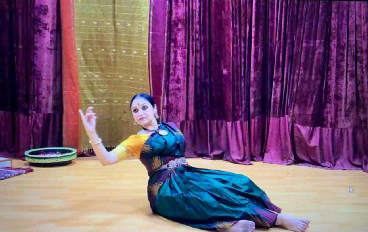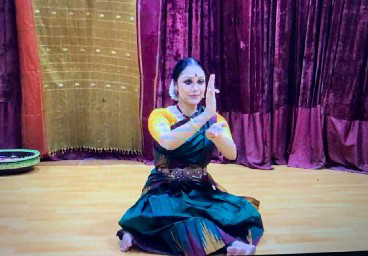Who better than acclaimed dancer, Rama Vaidyanathan, who in her own words, called herself a perfect amalgam, a “hybrid of the North and South Indian culture of India” to capture and bring alive the essence of the thumri and her own journey with incorporating it into the vocabulary of Bharatanatyam.

In a pre-recorded session where Rama Vaidyanathan shared stage with a bunch of eminent musicians — Dr Nabanita Chowdary on vocals, Mithilesh Kr Jha on tabla and Sumit Mishra on harmonium — the lecture demonstration literally transported the viewer to the court of Wajid Ali Shah of Lucknow, in whose period, somewhere in the 19th century, the thumri that literally is born out of the Hindi word, “thumakna” (meaning to move) found its genesis. It’s perhaps got to do with the curation mastery of Aravinth Kumaraswamy that Rama Vaidyanathan’s session was soon after Dr S Sowmya’s session on the Padams of the Veena Dhanammal bani. Rama Vaidyanathan drew interesting parallels between these two traditions reinforcing how they grew and became popular almost at the same time in two different cultures but were performed inherently by the courtesans who belonged to the hereditary families. “If you look at the Padam and the Thumri, you will notice they are both rich in poetic content with an accent on lyrics both the singer and the dancer attempt to portray subtle and varied shades of the meaning of the poetry which is usually focussed on the intimate, passionate moments with the lover, of a god who becomes a lover and of pining for a beloved who is sometimes the Lord; the speed or the pace is usually slow except the thumri picks up pace towards the end with the tabla. For me, these similarities across two cultures is a huge unifying factor in the history of Indian classical dance.” “As a dancer,” Rama said, “who studied Bharatnatyam in Delhi but grew up with access and exposure to Kathak and Hindustani music, I continue to be fascinated by the versatility of the Bharatanatyam idiom and its ability to transcend boundaries of language, musical genres, and cultures to come alive and create powerful pieces of poetry.”

To demonstrate this idea and to allow us understand and appreciate how the thumri weaves into the fabric of Bharatanatyam, and so seamlessly, Rama Vaidyanathan demonstrated two beautiful thumris.
Here’s an excerpt from a thumri is raag Pilu composed by the outstanding Bade Ghulam Ali Khan sahab of the Patiala gharana. The central motif here is that of laughter; as a friendly fight between Krishna’s friends and Radha’s friends, the thumri in Rama’s world sparkled with a joyous personality.
As a stark contrast to that, in raag Shivaranjani, the second thumri, Ro Ro Nain Gavaye, brought to fore a heroine who has been scorned by her lover who doesn’t show up as promised; forcing her to pine and grieve even as she burns ragingly in passion, wondering about a youth going wasted — Umariya beeti jaaye.
For a Bharatanatyam dancer, who is trained, honed and groomed to dance the padam, being able to portray the vipralabdha nayika (one deceived by her lover) isn’t new. But to understand it in the context of another context and culture, and dance in a way that the beauty of the language, the poetry and a musician from another genre, feel truly justified to find expression in a dance form that is unfamiliar with them all, is the genius of an artiste who owns her instrument, is multi-cultural and above all, one who has the unique ability to find similarities in differences, and vice versa and celebrate them all in her dance.
A dance of freedom, of sensuality, of unbridled emotions, of passion, of life!
This session was hosted by Seema of Apsaras Arts!
Up next
tomorrow 8 September — 4.30 pm — 5.30 pm : Chitrasena Dance Company — Kandyan Dance
8 September — 5.30 pm — 6.30 pm : Dr Srilatha Vinod and Anjana Anand — Silapathikaram — Dancer’s delight









